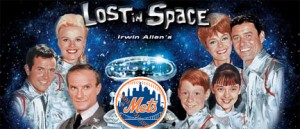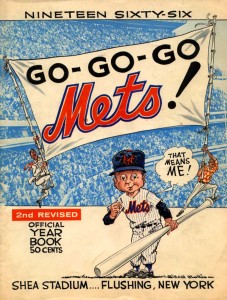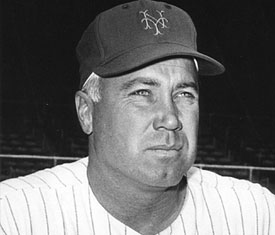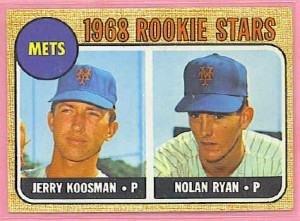New York Mets: Anatomy of a Franchise – Part 2, Lost in Space

Like the 1960s TV series, the New York Mets spent most of the 1960s Lost in Space.
The 1960’s among many other things were known for the next level of television programming. If the 50” were the “Golden Age of TV”, then the 1960’s were “The Teenage Years”. Oh my God!
I was a big Star Trek fan. I wanted to be Lincoln Hayes from the Mod Squad and Colonel Gallagher from 12 O’clock High. I didn’t watch the show that this article bares it’s name. I was told it was about a family that was lost in space. It had an old guy (no interest there) a whiney kid (oh yeah, just wonderful) and a talking robot that Spock would have said was interesting but totally illogical. Not for me by a long shot.
My high school years over I spent most of that summer watching the inaugural New York Mets team lose game after game after game. Seriously, the best part of really the first seven seasons was watching some of the greatest players to have ever played the game showcase their skills at the Polo Grounds.
Case in point, I’m really not sure if it was 1962 or 1963 and the St. Louis Cardinals were in town to play the Mets. It was about a zillion feet to dead center field and Willies catch off Vic Wertz in the 1954 World Series was still being talked about in the stands 8 or 9 years later.
Lou Brock was a dead red fastball hitter. His strike zone was from his ankles to his eyeballs and nobody I had ever seen or even have seen to this day could actually “tomahawk” a ball 550 feet with a swing from his eyes. That is exactly what Brock did that day and the ball landed about 15 rows up just to the right of dead centerfield. To this day it was the hardest hit ball I have ever seen. Awesome doesn’t describe it appropriately.
1963 to 1968 were the years that the Mets were literally Lost in Space. The team totaled 51 wins in 1963, In their first year (1964) at the new home of the Mets and New York Jets they won 53. 1965 produced 50 wins, actually 3 less wins than the previous year. 1966 was the first year that the Mets didn’t lose more than 100 games.

1966 was the first year the New York Mets didn't lose 100 games.
Wes Westrum replaced Casey Stengel in 1965 and Bing Devine of St Lois Cardinals fame became the General Manger in 1967. So, now was the time to move ahead right? Wrong. In 1967 the Mets took another step backwards and lost 101 games again.
There were some good moments during those years but mostly more of the same from year 1. In a game in Chicago they won a game 19-1 setting up the events and the black cat for 1969. But more on that in part 3. The shiny red apple was unveiled at Shea Stadium in 1964 and every time a Met would hit the ball out of the park the apple would rise from ground and the fans would go wild. It got stuck no fewer than 5 times that summer continuing the futility of this team.
My boyhood hero Duke Snider signed for the Mets in 1963. Believe me his better days were behind him, but oh that swing. I could imitate it perfectly and in my own mind that was the reason I made the Freshman Baseball Team at Northeastern University that spring of 1963. I played 2nd base, had deceptive speed for a chubby guy and could turn a mean double play.

Duke Snider returned to New York as a member of the Mets in 1963. He hit 14 home runs with 45 RBI.
In a game that spring against Boston University in front of 59 fans a guy about a foot taller and 30 pounds heavier than me tried to break up a double play and plowed right into my rather ample gut. He knocked himself out. I turned the double play, we won the only game of that rain shortened season and it took seven teammates to carry me off the team. This was definitely the highlight of my college career.
That spring the Mets signed Jimmy Piersall a true nut case whose life and antics reached the big screen in a fine baseball movie called “Fear Strikes Out” starring our even more favorite nut case Anthony Perkins, Psycho anyone?
These lost years also brought to the team the making of at that time, unknown to all of us, the beginning of the Miracle Mets. Bud Harrelson, Ron Swoboda, came in ‘63’. 64, it was Tug McGraw, Jerry Koosman. In 1965 Nolan Ryan signed and the Mets traded to Houston for Jerry Grote. Duffy Dyer Jim McAndrew came the same year along with Ken Boswell.
For the 1966 season Danny Frisella, Amos Otis, Ron Hunt , Jim Hickman, and Don Cardwell came to town. However the best acquisition in New York Mets history happened when The Mets team name was picked out of a hat. For me to think that Tom Seaver could have been a Brave or a Philly would have changed the course of the Mets history as well as mine.

Jerry Koosman and Nolan Ryan were among the crop of young talent being assembled by the Mets.
In 1967 pitchers Gary Gentry, Cal Koonce, Jon Matlock arrived and perhaps the key to the championship season to come came with the arrival of Tommy Agee along with Art Shamsky.
The loveable losers seemed to be going in the right direction.
My life was like a roller coaster, going ahead and seemingly backwards at the same time. In June of 1964, I lost my Dad. We had talked that spring about going to some games that summer at the new Shea Stadium that just opened a few moths prior.
I had to leave Northeastern that year because my responsibilities and priorities were forced to be changed. An interesting sidelight to those events that spring about two weeks before my Dad succumbed to a massive heart attack on his 50th birthday, I had talked to him about changing my major to Journalism and pursuing as career as a sports journalist. It never happened.
Editor’s Note: We will be running all seven parts of the New York Mets: Anatomy of a Franchise series during the month of October, so please check regularly to read the next installment.
Click Here to read Part 1: The Inception
Richard Marsh is a die-hard fan of the Mets and Jets. He is the author of “The Blog” From Vegas Rich and is also a featured contributor on Bleacher Report.